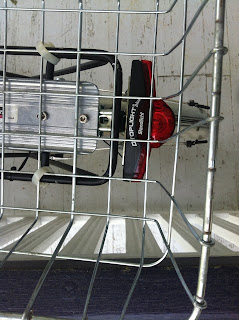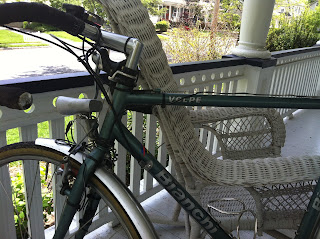I recently built myself a new road racing bike. I don't ride in road races, but riding a road racing bike is fun whether I'm commuting or out on a fun weekend ride.
Building the bike
I bought the frameset for this bike from my friend Dan, the creator of this blog. He had bought it on ebay for his girlfriend, but when it arrived, it wasn't quite the color she expected. The photos had some distortion which gave it a blue tint which doesn't exist.
The frame is made of titanium, and the fork is aluminum. Dan says the frameset is from 1994. Rumor has it that it was made by a now-defunct company called Clark-Kent with a license to use the Lemond name. Clark-Kent was so named from the last names of the two builders in the company.
My friend John gave me some of the components, the hubs and the crankset, which was terribly nice of him. The hubs and crankset are Campagnolo Record 10-speed. These components are relatively rare in the US. I bought a Miche cassette for the rear hub from xxcycle.com in France and Campagnolo Veloce derailleurs from Ribble in the UK. My friend David sold me the Campagnolo Veloce shifters, barely used.
The drivetrain is 2x10. Chainrings are 39/53, and the cassette cogs are 12 through 25. The lowest gear is 42 inches, and the highest is 119 inches.
I used a handebar and stem I had on hand. I think they are from some old Japanese bike. There are no labels on them.
I also used tires on hand. The rear is a Vittoria Rubino Pro Slick, and the front is a Continental Grand Prix 4000.
I built the wheels myself, using custom-cut spokes from a guy named Lee. I used a slightly unusual design, using 14/17 gauge spokes in the front wheel and on the non-drive side of the rear wheel. I used 14/15 gauge spokes on the drive side of the rear wheel. I bought Pacenti rims from Velomine. As it turns out, these rims are taller than they should be, and mounting tires on them is unreasonably difficult. I carry a special tire lever, in case I have to fix a flat on the road.
Other components include a Terry Butterfly saddle and Ritchey pedals, which both use titanium for light weight.
Brakes are SunTour Sprint, which are anachronistic, made before the bike. They work very well and are fairly handsome. The chain is KMC. The seatpost is Sugino.
The hardest part of building the bike was mounting the brake lever/shifters (aka brifters) onto the handlebars and routing the cables through them. The rest of the process was nearly trouble free. The bottom bracket spindle seems to be too long, and the chain is too far out. I might fix this, but so far, it hasn't caused much trouble.
Riding the bike
As you would expect, the bike is light and nimble. Total weight is right around 20 pounds (9 kg). The wheelbase is short, so it requires extra attention. On the other hand, I can make turns at quickly, and I can squeeze between objects that are close together at irresponsible speeds. The bike makes hill climbing easy, even though its lowest gear isn't very low.
I never before used a modern Campagnolo drivetrain before. It seems very solid and responsive. The lever design is very ergonomic. I can shift from nearly any hand position on the handlebars. With the gears spaced so close together, and with the shifters placed so conveniently, it is convenient to shift frequently. Each shift makes a small change in ratio, so I can maintain a constant level of effort if i want to. This, combined with the bike's lightness, allows me to put more effort overall. When I commute to work on this bike, I end up going a lot faster than on my heavier bikes. It's not merely that a lighter bike goes faster for a given amount of effort. It's also that increasing my effort doesn't punish me as much. I think this accounts for most of the speed gain. You have to try it to understand what I'm saying.
Comfort is not as great as on other bikes, because it is optimized for speed. I can see riding this bike for 50 miles at a shot but not for 100 miles. The frame would not accept tires that are much wider, so vibration goes from road to body without much damping. This leads to fatigue.
As much as I wanted to like this saddle, I think it has to go. The middle section bears a bit too hard on the tendons in my groin. A better saddle will probably reduce fatigue. I notice the problem more in the evening than in the morning.
The frame is a size 53 cm (seat tube), which is smaller than I usually ride. This places the handlebars low for me. It seems OK, perhaps because the horizontal reach seems less than usual. I haven't ridden more than 14 miles at a stretch yet. I'll see how it is on longer rides.
Here it is parked in my office.
There are more pictures of the bike here.































